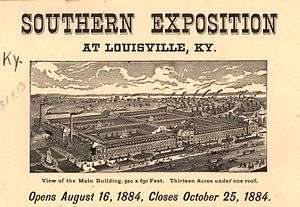Southern Exposition

The Southern Exposition was a five-year series of World's fairs held in the city of Louisville, Kentucky, from 1883 to 1887 in what is now Louisville's Old Louisville neighborhood. The exposition, held for 100 days each year on 45 acres (180,000 m2) immediately south of Central Park, which is now the St. James-Belgravia Historic District, was essentially an industrial and mercantile show. At the time, the exposition was larger than any previous American exhibition with the exception of the Centennial Exposition held in Philadelphia in 1876. U.S. President Chester A. Arthur opened the first annual exposition on August 1, 1883.
Highlights
One highlight of the show was the largest to-date installation of incandescent light bulbs, having been recently invented by Thomas Edison (a resident of Louisville sixteen years before), to bring light to the exposition in the nighttime. The contract with the Louisville Board of Trade was for 5,000 incandescent lamps. 4,600 lamps for the exhibition hall and 400 for an art gallery, more than all the lamps installed in New York City at that time, were used.
George H. Yater writes in his book Two Hundred Years at the Fall of the Ohio:
| “ | The Exposition was the first large space lighted by incandescence and many electrical pioneers felt that the Louisville success did more to stimulate the growth of interior electric lighting than any other Edison plant. | ” |
-

"Birds-eye view of Louisville from the river front and Southern Exposition, 1883" by William F. Clarke
See also
- Columbia Building
- The Filson Historical Society
- History of Louisville, Kentucky
- Louisville in the American Civil War
- Louisville mayors: Charles Donald Jacob and P. Booker Reed
- March 1890 middle Mississippi Valley tornado outbreak
- St. James Court Art Show - takes place in the same location as the Southern Exposition
- Thomas Edison House
References
- Yater, George H. (1987). Two Hundred Years at the Fall of the Ohio: A History of Louisville and Jefferson County (2nd ed.). Filson Club, Incorporated.
Further reading
- Bush, Bryan S. (2011). Louisville's Southern Exposition, 1883-1887: The City of Progress. Charleston, South Carolina: The History Press. ISBN 978-1-60949-143-7.
External links
- "'Went to the Exposition Tonight': Louisville's 1883 Southern Exposition" — Article by Kathryn Anne Bratcher of The Filson Historical Society
- "Southern Exposition: 1883-1887" — Article by Civil War historian/author Bryan S. Bush